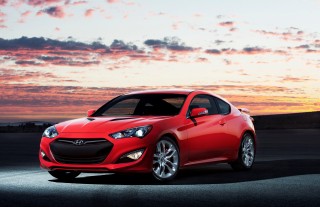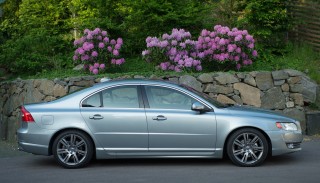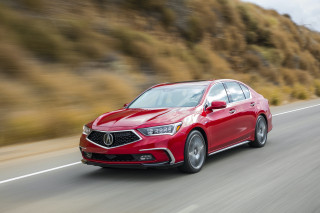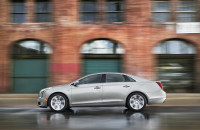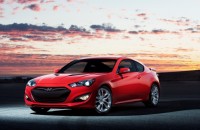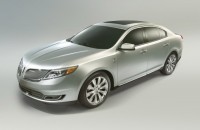Likes
- Smooth V-6 growl
- Gas mileage estimates lead the class
- Interesting new safety features
- More spacious rear seat
- Pure, clear Krell audio sound
Dislikes
- Design isn't distinctive
- Rear-wheel steering is a pretty exotic solution
- Multiple screens, multiple guesses?
- Less rear-seat head room than there seems to be
Buying tip
features & specs
The 2016 Acura RLX offers some minor updates to an already competent—if subtle—luxury package. It's an interesting alternative to the other cars in its class.
The Acura RLX is a subtle interpretation of luxury for the massive automaker. It may not appeal to everyone with its simple and straightforward design--inside and out. At equal turns, the RLX fades into the background, but it's also the luxury automaker's flagship. We think the combination of these traits makes the RLX an intriguing outlier in the market.
Acura has seen fit to introduce some early updates to the RLX for 2016, just two years into the model's run. The changes coincide with modifications to just about all of Acura's 2016 models. For this big sedan, the adjustments are mostly minor, but they include reintroducing the Sport Hybrid back into the lineup after its curious absence for the abbreviated 2015 model year. The active-safety offerings get some additions, while the suspension has been tuned, and all models will now come with 19-inch wheels.
This is a sedan that has understatement down pat, although it runs lean on sizzle. The design borrows from the BMW 5-Series, adding a softer Acura boomerang of chrome to the front end, and a hint of muscle over its front fenders. It's a no-drama zone from LED headlight to LED taillight, elegant in the same way the cabin is pretty and handsomely constructed, orchestrated instead of inspired. The leather and grained plastic are better than in any Acura we've sampled—they just need a touch of alchemy.
Interior space is a factor Acura hopes will appeal to RLX lookers. It remains about the same size as the outgoing RL sedan, although overhang has been shortened somewhat and the wheelbase is 2 inches longer—which together with 2 inches of width, in all, means more passenger space inside. The front seats are supple and trimmed in very rich leather, but rear head room is scant for tall adults, and trunk space is only average.
The front-drive RLX skips the adaptive suspensions common in the class and instead goes for a well-tuned set of coils, links, and digressive dampers. It's a setup that is well aware of what the RLX wants to be: a mildly cushy cruiser, with only token amounts of road-surface feedback. That's what makes the RLX's electric steering system so unusual: it has actuators on the back wheels that work in concert to deliver rear-wheel steering, an effect that lends stability to the RLX on the interstate, but sounds like an exotic solution for a car without high-performance intentions. For 2016, the suspension gets tuned with new spring rates, upgraded dampers, and a less-stiff rear stabilizer bar. Acura went as far as redoing the front shock mounts and replacing the rear bump stops.
Those who want stronger performance will be steered toward the Sport Hybrid Super Handling All-Wheel Drive model. The Sport Hybrid system is a pretty ingenious setup. A hybridized V-6 drives the front wheels, while an all-electric rear differential with two motors sends torque to the rear wheels, recreating digitally the all-wheel-drive wonder that Acura has for so long been able to create with its mechanical SH-AWD systems. The engineering smarts extend to the 7-speed dual-clutch transmission up front, which uses the rear electric motors to get things going from a stop, which avoids the tendency of dual-clutches to step off in a jerky, unluxurious way. The result of all this is refinement and superb handling, with all-electric torque vectoring at the rear to keep the car stable and aid turn-in. While performance is the priority over fuel efficiency with this hybrid system, it still boosts mileage up to 28 mpg city, 32 highway. After being offered briefly in 2014, the Sport Hybrid was absent for the RLX's abbreviated 2015 model year and will rejoin the lineup in spring as a 2016 model.
Safety is again a focus for Acura's flagship sedan. The brand's first application of active lane control is available, and all RLX sedans have standard forward-collision warning and lane-departure warning. In addition to the usual roster of safety features and airbags, the RLX includes a driver's front knee bag. The RLX has earned top five-star results from the federal government in every category. It's also an IIHS Top Safety Pick+ vehicle, with top ratings in every category. The optional adaptive cruise control and lane-keeping systems even work together as a follow function: the RLX will steer itself at low speeds behind another car, say, in stop-and-go traffic. The system isn't calibrated as well as in other vehicles, though; its closest setting is still too far away for tight traffic, letting others cut in front, which then sets it off into aggressive braking to keep the distance. As part of the 2016 update, Acura has rebranded its safety suite as AcuraWatch. It has added an available surround-view camera system, as well as a road-departure mitigation system and cross-traffic monitoring that can detect passing vehicles when backing up.
The non-hybrid RLX is offered in just three trim levels for 2016, down from five for 2015: RLX with Navigation, RLX with Technology package, and RLX with Advance package. The base model without navigation is now gone, as is the Krell Audio package that sat between the Technology and Advance models. All have an extensive list of features, including dual LCD displays for infotainment functions, while upper trim levels get the AcuraLink Communication system and the Aha streaming-audio interface as well as an expanded range of infotainment and connectivity features based on smartphone integration. The navigation system includes surface-street traffic, and security features include stolen vehicle tracking, airbag deployment notification remote locking and unlocking, and 24-hour concierge services.
Even with the updates made for 2016, Acura has not increased prices model-to-model. Front-drive 2016 RLX models start from just above $50,000, while the top Advance crests the $60,000 mark. Pricing for the Sport Hybrid starts at $60,890.
The front-drive, non-hybrid RLX earns gas-mileage ratings of 20 mpg city, 31 highway, 24 combined. EPA ratings for the Sport Hybrid models jump to 28/32/30 mpg.
2016 Acura RLX Styling
The RLX has a universal look--which some would call tame.
The RLX has a straightforward look that is handsome, but also forgettable. Its biggest risk is its jeweled headlights, with don't contribute much beyond the bland front end. The RLX also blends in with the smaller Acura sedans, the TLX and ILX, and arguably features the tamest styling of the trio.
While the soft visuals may bring in some customers, competitors are taking a more aggressive approach with their looks and it's paying off. For example, the gracious Audi A7, Jaguar XF, and Cadillac's XTS have lines all their own and they're better for it.
The RLX, on the other hand, is less apt to catch your eye in traffic. There's nothing wrong with the stance or the proportions; the BMW-esque turn to the roofline even has enough distance between it and the original to avoid a copycat look. The rest is subtle but graceful, from the LED headlights to the curve stamped over the front wheels, on back to the LED taillights. The smooth lines are definitely attractive—but no element is groundbreaking. It's a car that blends into the background, which is the idea of luxury for some, we imagine.
The cabin is a functional, nicely detailed place to check off driving tasks, but it's more of the same. It falls in the gap between the opposing ways drivers tend to define luxury: it doesn't wrap itself in the precise modern design cues that define most Audi cockpits, nor does it have the pervasive opulence that fills every Jaguar cabin. That said, the choice of materials, grains, and finishes is point-perfect in the RLX. It has the refinement down pat but lacks the sense of drama that's become a basic requirement in cars of its ilk.
For 2016, the styling changes are limited to 19-inch wheels becoming standard across the lineup.
2016 Acura RLX Performance
The RLX Hybrid has unusual driving zest for a gas-electric car; otherwise, the RLX's performance is above average.
Unlike many of its competitors, the RLX doesn't take a high-horsepower approach to performance. Instead, it uses unique technological solutions to differentiate itself. While the base powertrain is nothing to get too excited about, the available Sport Hybrid with Super Handling All-Wheel Drive makes a solid case for itself, both as a performance setup and in the way it saves fuel.
Even among the milder versions of the other sedans in its class, the front-drive Acura RLX's 310-horsepower, 3.5-liter V-6 isn't a spec leader, nor is its 272 pound-feet of torque. It's up 10 hp and 1 lb-ft over the RL's 3.7-liter V-6, but there's not much urgency in the way the RLX pulls uniformly away from a stop, or in its relaxed uptake. It's a contrast to the Lexus GS, which has some peaks whipped into its performance, though it doesn't necessarily feel any quicker than the RLX—both sit squarely in the six-second 0-60 mph range.
The front-drive RLX sports an automatic transmission and shift paddles for sporty driving, but it's still a 6-speed automatic that the RL used. Upshifts are very smooth, while downshifts can be more visible. More competitors are switching over to 8-speed automatics, and we think Acura should do the same. More, closely spaced gears could help take off and bring the RLX in line with others that are quicker.
The front-drive model's handling benefits from a trick four-wheel-steering system, which uses electric actuators at the rear to add just a few degrees of lock. The system, called Precision All-Wheel Steer, or P-AWS, is enough to make the front-driver feel a little more solid in tight turns than most barges with the layout. In lane changes, all four wheels move in the same direction. On a curving road, P-AWS can steer the rear wheels up to two degrees in the opposite direction of the front wheels, to cut a sharper line. It's an effect that can be helpful in daily driving, mitigating some of the width that's been baked into the RLX's platform.
On a racetrack or tight back road, the system can require some calibration to your driving style. Drive it quickly in an uphill straight line, then dive down into a sharp turn, and the quick oversteer set up by P-AWS is unlike any other system before it. It's a glint of edge in a car that doesn't necessarily need one, or pretend to be a sports car.
Extra performance is available in the form of the RLX's Sport Hybrid model, which packs a special new three-motor hybrid system. It's a novel concept, and what has us most interested is that a version of this setup will make its way into the future NSX supercar. The basis is a 3.5-liter V-6 mated to a new 7-speed dual-clutch automated manual gearbox that has a 35-kw motor built in. All-wheel drive, and the real handling genius, lies in the two-motor electric rear differential, which performs torque vectoring while also helping power the car and move it away from a stop smoothly. Instead of using a traditional first gear in the dual-clutch, the car instead relies on the motors for initial propulsion, thus avoiding the jerkiness that can come from the transmission's automated clutch take-up. The rear motors each put out 27 kw of power and can act to recapture electricity for the battery. The Sport Hybrid SH-AWD system makes 377 hp and 377 lb-ft of torque.
The Sport Hybrid is the model to have if you like the idea of an under-the-radar sport sedan with surprisingly good dynamics. Head into a corner a little too hot, and using what feels like physics-defying magic the RLX sends power selectively to each of the rear wheels—the outside rear wheel, especially—nudging your trajectory back right where it should be. It can be rather unsettling at first, because you feel that nudge from the driver's seat, but not through the steering wheel. The novelty doesn't wear off, however. We can see the RLX's attributes being just as useful on a weather-slicked highway, making an emergency maneuver, as it was on the mostly empty back roads where we drove the car.
Otherwise, the Sport Hybrid is extremely responsive to stabs of the throttle, and it accelerates almost like an electric car—with the motor systems filling in neatly wherever you can hear the dual-clutch gearbox grab for the next gear. It's an entirely different, more exotic (and exciting) driving experience than in the front-drive RLX—and a bit unexpected, given the rest of the car's conservative presentation.
Both RLX models have a conventional suspension tuned for comfort first, with a bit of lively feel dialed in via electric power steering and either the actuators at the rear wheels or the trick electric differential. The RLX's steering has a light touch on center that's very noticeable at parking speeds, entirely intentional, before it transitions to a more consistent heft. The transition's less obvious at speed, where the ability to steer its rear tires becomes the RLX's most significant new hardware bullet point. For 2016, Acura has given the suspension system a pretty thorough overhaul, touching the dampers, shocks, rear stabilizer bar, front shock mounts, and rear bump stops. The goal was to reduce noise, vibration, and harshness, and also further soften the suspension's responses, hopefully without dulling the handling. We will update this space once we have a chance to drive the updated model.
The base RLX is sprung and damped well enough to absorb stretches of broken pavement with little fuss, and it leans into corners casually. For that kind of driving duty, you'll never miss an adjustable suspension system or adaptive shocks like the ones commonly found on competitors. Those systems can be tailored to a wider range of performance limits, but since the RLX doesn't intend to ultra-high performance it gets by as a mono-spec machine that knows its limits and makes the best of them.
2016 Acura RLX Comfort & Quality
A well-fitted and spacious cabin in the RLX lacks a little rear-seat headroom.
The RLX fixes most of the RL's foibles—including a tight rear cabin and lack of storage space—although we're still left unimpressed by rear-seat head room. This is another sacrifice to the design gods, apparently, a result of the swoopy rear roofline. In all, the RLX provides a comfortable experience with space that's mostly on par with the other large cars in its price range.
The RLX is fractionally longer than the RL: the wheelbase has been stretched by 2 inches and it is 1.8 inches wider overall. Those size differences register instantly once you get inside.
Climb inside the RLX and a chime is accompanied by a pleasant welcome splash screen from the infotainment. It's strangely emotional from an automaker that we've assumed to always be so cold. The interior looks large, and it's not all visual tricks. The clever stylists have had their way, though, creating rectangular passenger spaces that read more like architecture than car design.
True to the RL's legacy, the front seats fit like broad-backed executive desk chairs. They offer 12-way adjustment and standard heating, with ventilation an option. The center console is wide, but manages to avoid cutting into space for people. Head room is fine for tall adults up front, and Acura says shoulder room is among the best in the category, though the hand-picked competition consists of more German models than American, which is to the RLX's advantage.
The back seat looks enormous at first glance and mostly makes good on that visual promise. The rear door openings are cut large, making it easy to slide into the three-passenger space. Cushions are wide and long under the leg for great support; it's the vertical dimension that gives us problems. Because of the slope of the roof in back, taller folks will rub their heads on the ceiling. We almost expect this in smaller family sedans but rarely encounter in something this size. There's somewhat less shoulder room than expected, as well. The rear seats can be optioned with heating, but there is no massage function or anything like the fancy reclining seats available in the big German sedans. Such a feature might be helpful for those with headroom issues, come to think of it.
In a nice change from the RL, Acura has graced the RLX with plenty of small-item storage. The large center console is the place to hide valuable objects; its clever lid opens from either side and can also slide with a lovely damping toward the rear. The trunk is a slightly different story, with 14.9 cubic feet of space, or less if you get the top audio system. The floor is thankfully flat, but the space is a couple of gym bags smaller than the hold in the MKS. The Sport Hybrid model's battery pack reduces room further, to 12 cubic feet; it's the only real sacrifice for opting for the hybrid, aside from the increased price.
The ride is comfortable with either powertrain setup, with Acura aiming for bump suppression with a bit of a sporty edge. You feel the road when you're really leaning on it; otherwise, the RL's serenity comes through nicely. We haven't yet driven the updated 2016 model, however, which promises some extra cushion, hopefully not at the expense of handling and that twinge of sport the original model provided.
We were duly impressed by the uptick in materials used in the RLX. Everything you can touch feels as it should, a noticeable step up from Accords and even the smaller Acuras. The presence of an engine note is a welcome change for Acura—not noise to be filtered out, we think. The RLX's hollow-core wheels were meant to address tire noise, but there's still some to be heard.
2016 Acura RLX Safety
The RLX has top-tier crash ratings, and it benefits from a decade of new safety developments.
The RLX has been tested by federal and independent safety authorities and earned top results from both. The big Acura boasts lots of safety technologies, including Honda's recent advances in crash mitigation and prevention. For 2016, the safety-tech offerings get further additions and improvements.
All RLX sedans come with the usual airbags and stability control. A driver-side knee airbag is standard as well, as are a rearview camera and Bluetooth, two features we consider almost essential in combating driver inattention. The RLX's rearview camera actually displays a 180-degree view of its surroundings, for even better visibility. It helps too that the RLX doesn't have the very thick roof pillars or very small rear glass of, say, the Lincoln MKS.
Among the options offered to RLX buyers are blind-spot monitors—a feature we like for the added information it gives drivers who fail to check their rearview mirrors. There's also adaptive cruise control and a lane-departure warning and active lane control; together with automatic emergency braking, the chorus of sensors and alerts can actually prevent lower-speed accidents—and even can grant a degree of autonomous driving. When the adaptive cruise control is set, the RLX will stop itself at lower speeds—and all the driver has to do to re-engage is to hit "Resume" on the steering wheel, or tap the gas.
For its 2016 update, the RLX gets a surround-view camera system, which stitches together views from four spots on the car to create an overhead view. The surround-view camera is included on the Advance package. Acura has also rebranded the safety suite to AcuraWatch and is now including road-departure mitigation and rear cross-traffic detection. The new road departure system uses a combination of steering correction and braking force to reduce the chances of leaving the road once the front-facing camera detects wandering.
And ostensibly for safety's sake, the RLX loses one of the features we've long appreciated in Acura vehicles. Acura now blocks all touchscreen data entry while the car is in motion. The logic is unassailable if the driver is the only one in the car, removing one popular avenue for distraction, but what about front passengers who want to use the system? In this case the "feature" becomes an annoyance, so you and your copilot have to program the screen before setting off, or else use the voice recognition for arguably similar distraction while driving.
The IIHS calls the RLX a Top Safety Pick+ after the sedan earned top "Good" ratings in all of its categories, including the notoriously trick small overlap front crash test. And in federal testing, conducted by the NHTSA, the 2016 RLX earned perfect five-star scores in front and side crash tests, as well as all subcategories. It also earned a top five-star result in the rollover test, which consists of static and dynamic components.
2016 Acura RLX Features
Smartphone connectivity and amazing Krell audio are undercut somewhat by a finicky, dual-screen infotainment system.
The RLX's 2016 update changed little in the way of included equipment aside from safety systems, but it did trim the lineup down to just three versions of the front-drive model. The Sport Hybrid starts at $60,890.
All models include plenty of standard equipment, but options can drive the bottom line too far to stay competitive--top models can sail past $60,000. Last year's standard RLX without navigation has been shelved, which effectively raised the base price for an RLX. A model with the Krell audio system used to sit between the Technology and Advance package cars but has been jettisoned in favor of a more streamlined lineup as well. All models now include the 19-inch wheels that were previously reserved for cars with the Technology package and higher.
At $55,390, the base RLX (which is called RLX with Navigation) has a price and feature set that put it nicely in line with cars we'd cross-shop. Its standard features include power windows, locks, and mirrors; cruise control; automatic climate control; a power sunroof; keyless ignition; leather upholstery; 12-way power heated front seats; power tilt/telescoping steering; automatic headlights; Bluetooth; a rearview camera; and an 8.0-inch upper LCD and a 7.0-inch lower LCD touchscreen that display output for the AM/FM/CD/XM audio system, which also includes 10 speakers, HD radio, a USB port and an aux jack. The navigation system includes voice commands and AcuraLink, a suite of services discussed below.
The $55,390 RLX with Technology Package refines the leather choice to "Milano" hides; it also the full AcuraWatch safety suite—adaptive cruise with low-speed follow, collision mitigation braking, forward collision warning, lane-departure warning, active lane control, road-departure mitigation, blind-spot monitors, a multi-view rear camera with dynamic guidelines, and rear-traffic monitoring—acoustic glass, four more speakers, retractable side mirrors, and rain-sensing wipers.
At the top of the lineup, the $61,390 RLX with Advance Package front and rear parking sensors; the surround-view camera system; ventilation for the front seats; heated rear seats; a 14-speaker Krell audio system with reference-quality sound, one of the near-overkill systems usually found on ultra-premium brands; and power sunshades.
The AcuraWatch suite is also available on the RLX with Navigation.
The RLX Hybrid with all-wheel drive and Technology Package starts at $60,890. At $66,890, the RLX comes equipped with Advance Package.
Of all the new features integrated into the RLX, the AcuraLink system and the dual-screen output of the infotainment system will take the most time to learn. The logic behind both sounds reasonable. AcuraLink's basic setup uses a smartphone app as the gatekeeper for dozens of other apps like Facebook. With one link they're all accessible through the head unit, and new information, like points of interest, can be accessed without massive, regular updates. Still, it's an additional interface between the driver and safe driving. AcuraLink also offers paid services to connect to live operators, a service we've never been sold on or quite understood in the smartphone era.
Then there's the dual-screen setup itself. It's an interesting spin on the complexity of systems like MyLincoln Touch and Cadillac's CUE. By splitting functions, Acura hopes to keep the non-touch-information on the larger, more visible screen, while controls like audio toggles are placed closer to the driver on the smaller touch-sensitive display. A third color display between the gauges offers more information.
You might guess that it all might be too much, and you'd be right. There's nothing intuitive about hunting between screens for settings or information, and it can actually distract drivers from paying attention to the road. In addition, the low placement of the touchscreen also takes eyes away, something we're not particularly fond of.
All RLX models carry Acura's standard warranty of four years or 50,000 miles.
2016 Acura RLX Fuel Economy
The Hybrid's fuel-economy payoffs are more meager than expected.
The Acura RLX is not only more powerful than the RL sedan it replaces, but it's also more fuel-efficient. Front-drive RLX sedans receive fairly good EPA mileage ratings, especially in the highway test, but the Sport Hybrid model is the star when it comes to fuel economy.
The front-drive, non-hybrid RLX earns gas-mileage ratings of 20 mpg city, 31 highway, 24 combined. In the class of cars it compares with most directly, that's a hit: nothing comes close to those ratings outside of the Lexus GS and Infiniti M hybrids, and vehicles like the turbocharged Lincoln MKS are much further off the RLX's pace. It's also a strong step forward from the old RL's numbers of 17/24/20 mpg.
Models with the new Sport Hybrid system will be the best-performing in the lineup, not only from a performance perspective—as the system has more power and a sophisticated all-wheel-drive setup—but from a green one too. EPA ratings for these jump to 28/32/30 mpg. The hybrid has a three-electric-motor system and lithium-ion battery pack in addition to a 3.5-liter V-6. That puts it up there with some of the diesel offerings from German competitors.







































































































